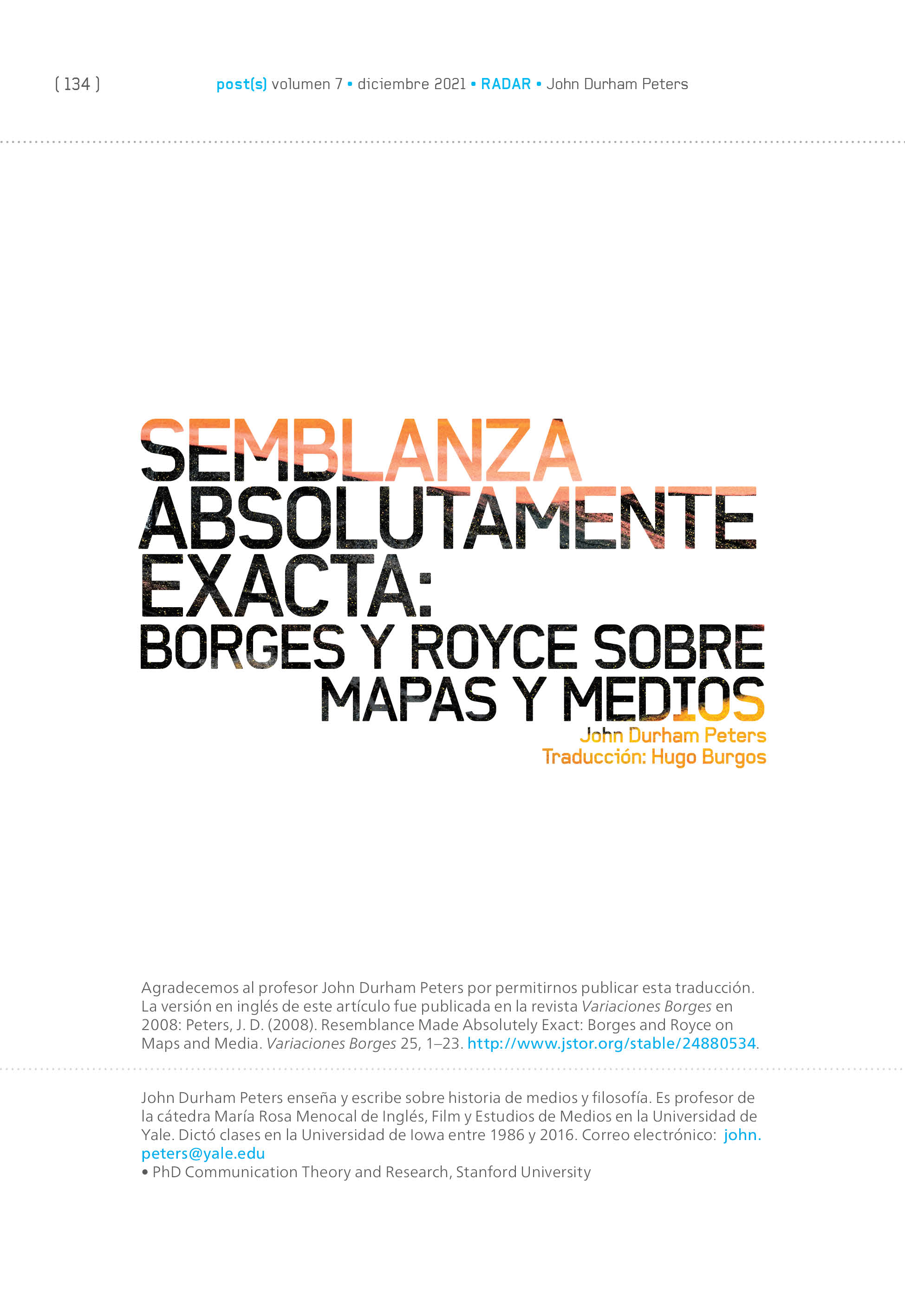Resemblance Made Absolutely Exact: Borges and Royce on Maps and Media

Published 2021-12-13
Keywords
- Josiah Royce,
- literature,
- Borges,
- Maps and Media
How to Cite
Abstract
Josiah Royce, el filósofo idealista estadounidense (1855-1916), es más conocido por los lectores de Borges por su conexión con un mapa dentro de un mapa dibujado en el suelo de Inglaterra de forma recursiva. De hecho, Borges valora "el mapa de Royce" lado al lado con su querida paradoja de Zenón en "Otro poema de los dones" (336), un catálogo al estilo Whitman de varias de sus cosas favoritas. Borges apreciaba a Royce como un colega que caminó a finales del siglo XIX entre la espesura del idealismo angloamericano y las nuevas matemáticas de números finitos. Más que una influencia para Borges, Royce fue un colega viajero, que llegó a un lugar similar después de haber pasado por Berkeley, Schopenhauer y Cantor.
Después de catalogar las conexiones entre los dos pensadores y explicar el mapa de Royce, en este ensayo sugeriré que ambos personajes son teóricos del infinito y metafísicos de la copia, que ofrecen sugerencias fértiles para nuestra comprensión de los medios, en general, y de los mapas, en particular. Aunque Royce y Borges puedan aparentar ser arquitectos de estructuras idealistas sofocantes para algunos lectores, existe una diferencia: Royce piensa que sus figuras sobre el infinito realmente muestran la verdad sobre el universo. Borges encuentra en tales figuras las paradojas y deslizamientos intrínsecos a cualquier proyecto sobre duplicación perfecta, y su escepticismo en cuanto a la representación filosófica es diseñado, finalmente, para proveer oxígeno y salir de un sistema totalitario. En esto, veo a Borges como un seguidor de un amigo cercano de Royce, su colega de Harvard y antagonista filosófico: William James.
Downloads
References
- Almeida, I. (2002). Borges and Peirce, on abduction and maps. Semiotica 140, 13-31.
- Balderston, D. (1993). Out of Context: Historical Reference and the Representation of Reality in Borges. Duke University Press.
- Borges, J. L. (1986). Cuando la ficción vive de la ficción. Textos cautivos. Tusquets, 35-7.
- Borges, J. L. (1974). Magias parciales del Quijote. Otras inquisiciones. Emecé, 667-69.
- Borges, J. L. (1975). There Are More Things. El libro de arena. Emecé, 39-45.
- Borges, J. L. (1996a). Avatares de la tortuga. Obras completas 1: 1923-1949. Emecé. 254-58.
- Borges, J. L. (1996b). La doctrina de los ciclos. Obras completas 1: 1923-1949. Emecé, 385- 92.
- Borges, J. L. (1997). Naturalismo al día. Obras completas en colaboración. Emecé, 315-18.
- Borges, J. L. (2001). William James, Pragmatismo: Nota preliminar. Textos recobrados (1931-1955). Emecé, 219-21.
- Borges, J. L. (2005a). Nueva refutación del tiempo. Obras completas 2: 1952-1972. Emecé, 143-58.
- Borges, J. L. (2005b). Otro poema de los dones. Obras completas 2: 1952-1972. Emecé, 335-37.
- Borges, J. L. (2007). El Aleph. El Aleph. Alianza, 175-98.
- Carroll, L. (1893). Sylvie and Bruno Concluded. Macmillan.
- Clendenning, J. (1999). The Life and Thought of Josiah Royce. Revised and expanded edition. Vanderbilt University Press.
- Comellas, J. L. (2003). Historia de España moderna y contemporánea. Rialp.
- Dayan, L. M. (2006). Borges: cosmovisión fractal. Metapolitica 47: 58-61.
- Dubnick, H. L. (2001). Bodying Forth the Impossible: Metamorphosis, Mortality, and Aesthetics in the Works of Jorge Luis Borges. Enculturation 3:2. enculturation.gmu.edu/3_2/dubnick/ index.html
- Eliot, T. S. (1916). Experience and the Objects of Knowledge in the Philosophy of F. H. Bradley. Ph.D. Dissertation, Harvard University.
- Eliot, T. S. (1962). The Waste Land and Other Poems. HBJ.
- James, W. (1890). The Principles of Psychology. vols. Dover.
- Kasner, E., y Newman, J. (1940). Mathematics and the Imagination. Simon and Schuster.
- Kittler, F. A. (1986). Gramophon Film Typewriter. Brinkmann und Bose.
- Kuklick, B. (1977). The Rise of American Philosophy: Cambridge, Massachusetts, 1860-1930. Yale University Press.
- Mandelbrot, B. (1967) How Long is the Coast of Britain: Statistical Self- Similarity and Fractional Dimension. Science 156, 636-38.
- Mumford, L. (1934). Technics and Civilization. HBJ.
- Nubiola, J. (2001). WJ and Borges Again: The Riddle of the Correspondence with Macedonio Fernández. Streams of William James 3 (Fall), 10-11.
- Nubiola, J. (2005). Jorge Luis Borges y William James. Aproximaciones a la obra de William James: La formulación del pragmatismo. Biblioteca Nueva, UCM, 201-18. www.unav.es/ users/BorgesWilliamJames.html
- Nubiola, J., y Zalamea, F. (2006). Peirce y el mundo hispano. Lo que C. S. Peirce dijo sobre España y lo que el mundo hispánico ha dicho sobre Peirce. Ediciones Universidad de Navarra.
- Peirce, C. S. (1935-1966). Collected Papers. Vols. 1-8. Editado por C. Hartshorne, P. Weiss y A. W. Burks. Harvard University Press.
- Peitgen, H. O., Jürgens, H., y Saupe, D. (1992). Fractals for the Classroom: Part One. Springer-Verlag.
- Peters, J. D. (1999). Speaking into the Air: A History of the Idea of Communication. University of Chicago Press.
- Peters, J. D. (2003). Space, Time, and Communication Theory. Canadian Journal of Communication 28, 397-411.
- Royce, J. (1899, 1901). The World and the Individual. 2 vols. Macmillan.
- Royce, J. (1892). The Spirit of Modern Philosophy. Dover.
- Royce, J. (1885). The Religious Aspect of Philosophy. Harper and Row.
- Royce, J. (1908). The Philosophy of Loyalty. Macmillan.
- Royce, J. (1913). The Problem of Christianity. 2 vols. Macmillan.
- Russell, B. (1919). Introduction to Mathematical Philosophy. Allen & Unwin.
- Schwartz, M. M. (2007). Epistolary Affinities. Department of Communication Studies, University of Iowa.
- Selnes, G. (2007). Borges, Nietzsche, Cantor: Narratives of Influence. Ciber- letras 6, 4. http://www.lehman.cuny.edu/ciberletras/ v06/selnes.html
- Siegert, B. (2003). Passage des Digitalen: Zeichenpraktiken der neuzeitlichen Wissenschaften, 1500-1900. Brinkmann und Bose.
- Trotter, G. (2001). On Royce. Wadsworth.
